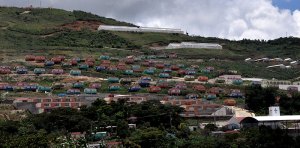There’s a short video making the rounds of some websites that focus on development aid. It was made by the Institute for Development Studies and takes the viewer into a house in Chiapas, one of a few hundred, built by the state government in what their planners are calling a ‘Pueblo Rural Sustentable,’ or rural sustainable town.
This particular sustainable town was called Santiago El Pinar and, according to Proceso magazine, cost almost 400 million pesos — or about $27 million — to erect. And in the words of the Chiapas government’s Institute of Rural Cities, the idea is “ to concentrate dispersed localities and faciltiate the provision of quality basic services and productive alternatives with dignified and paid jobs.”
The idea behind these towns is to bring indigenous peasant farmers, among the poorest in Mexico, out of their villages and into a central spot where there are proper roads, a school, a cooperative and a clinic. It’s not a terrible idea and the houses, painted in different colours, look nice perched on the ridge where they have been placed. The only problem is: they’re cheap and badly constructed, and the families who got them are leaving them in droves.
According to reports in the Mexican press, some families were willing to live in these houses despite the fact that they were still hauling water from a nearby stream and walking several miles to cultivate their bits of farmland.
I spent a fair amount of time in rural villages in 1994, the year the Zapatistas caught the world’s attention, and saw lots of rural houses. They were made with adobe, in general, or wood slats, with thatched roofs and were rather dark and basic. Sometimes a separate kitchen was built beside the house, which would be just a thatched, open pavilion structure with an area to build a fire and cook. Chickens and pigs wandered around at will, and bathroom facilities, in other words a pit latrine, were rare indeed.
So house with a corrugated metal roof, glass windows, a bathroom and a kitchen with a gas hook-up and running water would represent quite a change. But it’s a change that has proven to be ephemeral and raises some interesting issues.
Among them are: how can residents pay for gas and electricity if they are poor? Why build them with cheap materials — like, in this case, plasterboard, when, in fact, adobe is perfectly good and durable? And if these peasants had money and these houses were offered for sale, instead of being free, would any of them actually want to buy one? Would any of the city-bound planners in Tuxtla Gutierrez or Mexico City ever buy one, for example? And finally, what does the entire plan tell us abut how people with good intentions approach the whole notion of housing the poor?
I have lately been doing some research into the latter question, in the context of Haiti. It strikes me as interesting that organizations like Architects for Humanity have databases of useful and well-designed structures, created by professionals who are interested in innovation and at the same time recognize that the people who will use their structures need to have a say in what ends up getting built. Or that organizations like the National Slum Dwellers Federation in India have designed apartments that were lofty, well-lit and inexpensive to build. And yet, when it comes to the majority of housing that is actually built for the poor, one tends to see the same thing: nicely painted (sometimes) shoe boxes, whether assembled into apartment buildings or laid out in rows, that become ramshackle in a matter of months. Or 25 square metre plywood huts that become ovens in the hot sun. The paint wears off, the material warps, the roofs leak, the drains don’t work, the electricity gets cut off and there’s nowhere to build a fire for cooking. In short, things begin to fall apart — sometimes in a matter of months. And then you have – tada! — what’s known as a slum.
If you are living in a tent, or a thatch-roofed adobe hut, these houses may look pretty nice. But if given a chance to specify what is needed and what is preferred, probably no one would want to live in one of them.
So in Chiapas, where two such Pueblos have been assembled, and five more are planned – all as part of the Millennium Development Goals apparently — a lot of money is going down the drain and the poor are no better off.
It’s not hard to set up a consultation process with poor communities, to give them the construction material they want and get them to build themselves — after all, they have already built the houses they live in now — or to think about how they will pay for electricity. It just requires that governments and international bodies respect the poor, rather than seeking political gain — in the case of the former — or checking a box on a list — in the case of the latter.


